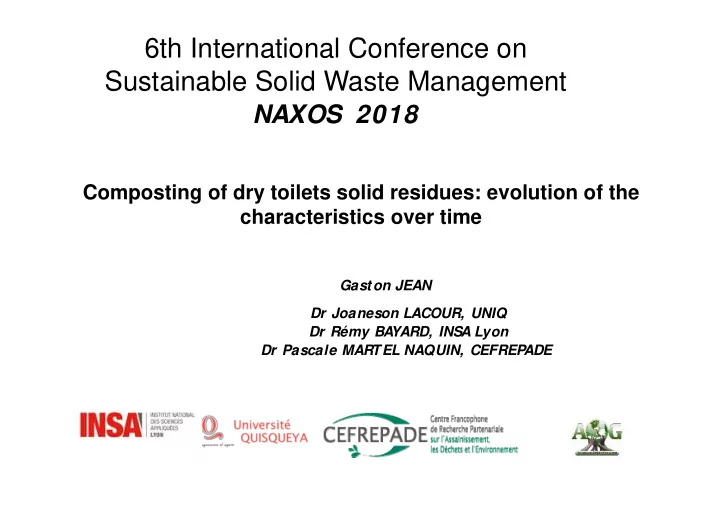

6th International Conference on Sustainable Solid Waste Management NAXOS 2018 Composting of dry toilets solid residues: evolution of the characteristics over time Gaston JEAN Dr Joaneson LACOUR, UNIQ Dr Rémy BA YARD, INSA Lyon Dr Pascale MARTEL NAQUIN, CEFREP ADE
PLAN CONTEXT OBJECTIVES PRESENTATION OF THE PILOTS RESULTS OF 100 L PILOTS (P1) RESULTS OF 300 L PILOTS (P2) CONCLUSION
CONTEXT 1/2 2,4 billion people without toilets (WHO / UNICEF, 2016) 71% live in rural areas More than 1 billion people (15% global pop) practice open defecation Open defecation is practiced by 90% in rural areas (WHO / UNICEF, 2013). Almost no collective sanitation system in developing countries 90% of poorly treated or untreated wastewater, responsible for many risks of contamination (WHO) Contamination of water by waste / excreta would be responsible of 80% of diseases and 25% of deaths (WHO)
CONTEXT In Haiti 72% of the population have no access to a proper sanitation system, including 15% in the metropolitan area of Port au Prince and 18% in other cities (UN, 2016). Polluting latrines ‐ Numerous open defecation sites 23% of the population practices open defecation, 41% in rural areas In some communities, especially in unconventional communities, people defecate in plastic bags that they drop anywhere. This phenomenon is called flying toilets. Water ‐ borne diseases are responsible for 17.5% of morbidity and mortality of children under 5 years of age (MSPP, 2005). Microorganisms of faecal origin have been detected in numerous samples of groundwater (Balthazard ‐ Accou et al., 2009)
OBJECTIVES Fight against open defecation by empowering communities and increasing the number of toilets reduce the number of cases of waterborne diseases by hygienizing faeces through composting Return the biomass to the soil
DRY DIVERSION TOILET MODEL
Residues collected over 12 months Masse totale collectée (kg) ‐ 23 familles 3846 Nombre de jours 381 Masse moyenne par jour (kg) 10,1 Masse moyenne par jour et par personne (kg) ‐ 88 personnes 0,11
RESIDUE, FAECES AND HUMIDITY
PRESENTATION OF PILOTS 100 L 5 first 100-liter pilots have been launched to monitor the rise in temperature and the quality of residues. P1 Water P2 Water + aerated by pieces of wood P3 Water + flipping P4 urine P5 Without specific conditions
TEMPERATURE EVOLUTION ‐ PILOTS 100L
PRESENTATION OF PILOTS 300 l 2/2 Series of 300 ‐ liter pilots P1:Bagasse ‐ Pin 2/3 P2:Bagasse ‐ Frêne 2/3 P3: Bagasse 100% P4: Bagasse 100%+ branchage P5: Frêne100%+ branchage
TEMPERATURE EVOLUTION ‐ PILOTS 300L
CONCLUSION When the residues are composted with significant volume, the temperature reached is favorable for a fast hygienization Dry litter toilets seem to be a good answer to fight against open defecation, very well accepted by the population This presentation shows a little part of the work conducted, still in progress, whose entire results, on the social, economic, environmental and sanitary aspects will be presented for my doctorate defense in December 2018
Thanks for your attention !
Recommend
More recommend